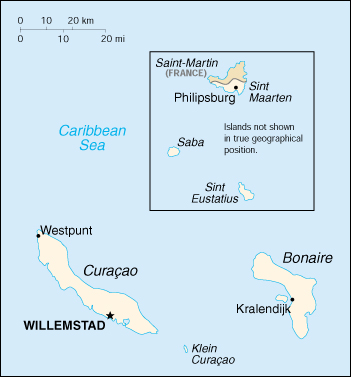Facts Of Netherlands Antilles
Background: Once the center of the Caribbean slave trade, the island of Curacao was hard hit by the abolition of slavery in 1863. Its prosperity (and that of neighboring Aruba) was restored in the early 20th century with the construction of oil refineries to service the newly discovered Venezuelan oil fields. The island of Sint Maarten is shared with France; its northern portion is named Saint Martin and is part of Guadeloupe.
Dependency status: part of the Kingdom of the Netherlands; full autonomy in internal affairs granted in 1954
Government type: parliamentary
Capital: Willemstad
Currency: 1 Netherlands Antillean guilder, gulden, or florin (NAf.) = 100 cents
Geography of the Netherlands Antilles
Location: Caribbean, two island groups in the Caribbean Sea – one includes Curacao and Bonaire north of Venezuela and the other is east of the Virgin Islands
Geographic coordinates: 12 15 N, 68 45 W
Area:
total: 960 sq km
land: 960 sq km
water: 0 sq km
note: includes Bonaire, Curacao, Saba, Sint Eustatius, and Sint Maarten (Dutch part of the island of Saint Martin)
Land boundaries:
total: 10.2 km
border countries: Guadeloupe (Saint Martin) 10.2 km
Coastline: 364 km
Maritime claims:
exclusive fishing zone: 12 nm
territorial sea: 12 nm
Climate: tropical; ameliorated by northeast trade winds
Terrain: generally hilly, volcanic interiors
Elevation extremes:
lowest point: Caribbean Sea 0 m
highest point: Mount Scenery 862 m
Natural resources: phosphates (Curacao only), salt (Bonaire only)
Land use:
arable land: 10%
permanent crops: 0%
permanent pastures: 0%
forests and woodland: 0%
other: 90% (1993 est.)
Natural hazards: Curacao and Bonaire are south of Caribbean hurricane belt and are rarely threatened; Sint Maarten, Saba, and Sint Eustatius are subject to hurricanes from July to October
Geography – note: the five islands of the Netherlands Antilles are divided geographically into the Leeward Islands (northern) group (Saba, Sint Eustatius, and Sint Maarten) and the Windward Islands (southern) group (Bonaire and Curacao).
People of the Netherlands Antilles
Population: 219,958 (July 2005 est.)
Age structure:
0-14 years: 25.21%
15-64 years: 66.99%
65 years and over: 7.8%
Population growth rate: 0.97%
Birth rate: 16.55 births/1,000 population
Death rate: 6.41 deaths/1,000 population
Net migration rate: -0.42 migrant(s)/1,000 population
Infant mortality rate: 11.4 deaths/1,000 live births
Life expectancy at birth:
total population: 74.94 years
male: 72.76 years
female: 77.22 years
Total fertility rate: 2.07 children born/woman
Nationality:
noun: Netherlands Antillean(s)
adjective: Netherlands Antillean
Ethnic groups: mixed black 85%, Carib Amerindian, white, East Asian
Religions: Roman Catholic, Protestant, Jewish, Seventh-Day Adventist
Languages: Dutch (official), Papiamento (a Spanish-Portuguese-Dutch-English dialect) predominates, English widely spoken, Spanish
Literacy:
definition: age 15 and over can read and write
total population: 98%
male: 98%
female: 99% (1981 est.)
Netherlands Antilles Economy
Economy – overview: Tourism, petroleum refining, and offshore finance are the mainstays of this small economy, which is closely tied to the outside world. Although GDP has declined slightly in each of the past five years, the islands enjoy a high per capita income and a well-developed infrastructure as compared with other countries in the region. Almost all consumer and capital goods are imported, with Venezuela, the US, and Mexico being the major suppliers. Poor soils and inadequate water supplies hamper the development of agriculture.
GDP: purchasing power parity – $2.4 billion (2000 est.)
GDP – real growth rate: -3.5% (2000 est.)
GDP – per capita: purchasing power parity – $11,400 (2000 est.)
GDP – composition by sector:
agriculture: 1%
industry: 15%
services: 84% (1996 est.)
Inflation rate (consumer prices): 6.4% (2000 est.)
Labor force: 89,000
Labor force – by occupation: agriculture 1%, industry 13%, services 86% (1994 est.)
Unemployment rate: 14.9% (1998 est.)
Budget:
revenues: $710.8 million
expenditures: $741.6 million, including capital expenditures of $NA (1997 est.)
Industries: tourism (Curacao, Sint Maarten, and Bonaire), petroleum refining (Curacao), petroleum transshipment facilities (Curacao and Bonaire), light manufacturing (Curacao)
Electricity – production: 1.11 billion kWh (1999)
Electricity – production by source:
fossil fuel: 100%
hydro: 0%
nuclear: 0%
other: 0% (1999)
Electricity – consumption: 1.032 billion kWh (1999)
Agriculture – products: aloes, sorghum, peanuts, vegetables, tropical fruit
Exports: $276 million (f.o.b., 2000)
Exports – commodities: petroleum products
Exports – partners: United States 17.5%, Guatemala 8%, Costa Rica 6.5%, The Bahamas 4.6%, Jamaica 4.1%, Chile 3.4% (1998)
Imports: $1.5 billion (f.o.b., 2000)
Imports – commodities: crude petroleum, food, manufactures
Imports – partners: Venezuela 35.3%, United States 21%, Mexico 9.8%, Italy 5.4%, Netherlands 4.8%, Brazil 3.1% (1998)
Debt – external: $1.35 billion (1996)
Economic aid – recipient: IMF provided $61 million in 2000, and the Netherlands continued its support with $40 million.
Currency: Netherlands Antillean guilder (ANG)
Map Of Netherlands Antilles
